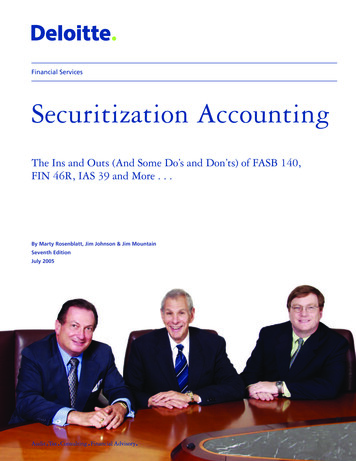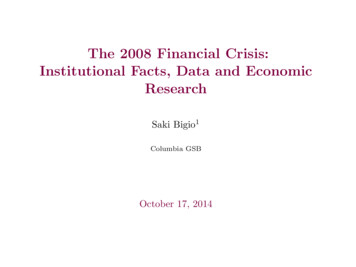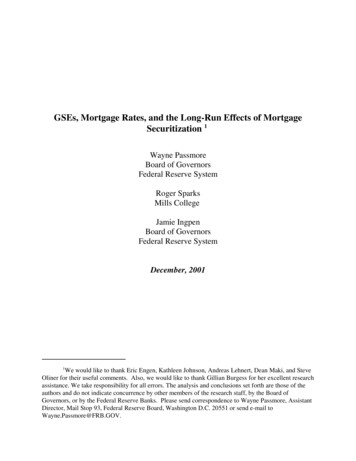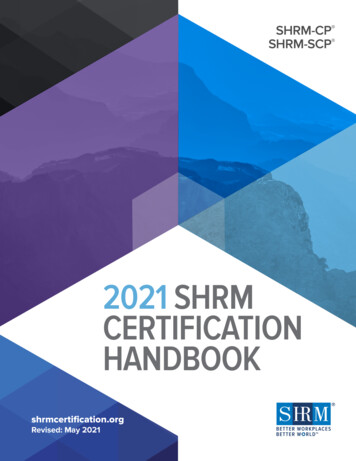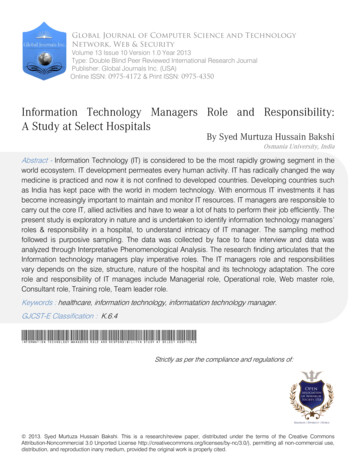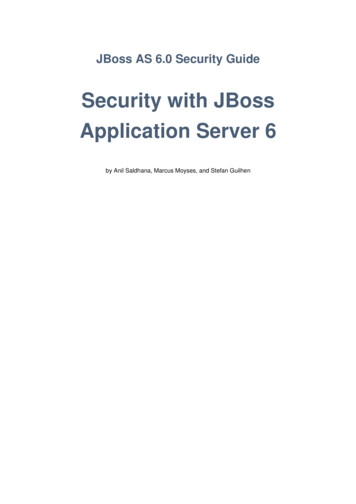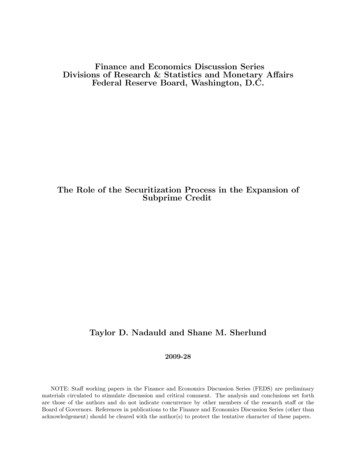
Transcription
Finance and Economics Discussion SeriesDivisions of Research & Statistics and Monetary AffairsFederal Reserve Board, Washington, D.C.The Role of the Securitization Process in the Expansion ofSubprime CreditTaylor D. Nadauld and Shane M. Sherlund2009-28NOTE: Staff working papers in the Finance and Economics Discussion Series (FEDS) are preliminarymaterials circulated to stimulate discussion and critical comment. The analysis and conclusions set forthare those of the authors and do not indicate concurrence by other members of the research staff or theBoard of Governors. References in publications to the Finance and Economics Discussion Series (other thanacknowledgement) should be cleared with the author(s) to protect the tentative character of these papers.
The Role of the Securitization Process in the Expansion of Subprime CreditTaylor D. Nadauld*Doctoral CandidateDepartment of FinanceThe Ohio State UniversityNadauld 1@fisher.osu.eduShane M. Sherlund*Senior EconomistHousehold and Real Estate FinanceBoard of Governors of the Federal Reserve SystemFirst Draft: May 2008This Draft: April 22, 2009AbstractWe analyze the structure and attributes of subprime mortgage-backed securitization dealsoriginated between 1997 and 2007. Our data set allows us to link loan-level data for over 6.7million subprime loans to the securitization deals into which the loans were sold. We show thatthe securitization process, including the assignment of credit ratings, provided incentives forsecuritizing banks to purchase loans of poor credit quality in areas with high rates of house priceappreciation. Increased demand from the secondary mortgage market for these types of loansappears to have facilitated easier credit in the primary mortgage market. To test this hypothesis,we identify an event which represents an external shock to the relative demand for subprimemortgages in the secondary market. We show that following the SEC’s adoption of rules reducingcapital requirements on certain broker dealers in 2004, five large deal underwritersdisproportionately increased their purchasing activity relative to competing underwriters in ZIPcodes with the highest realized rates of house price appreciation but lower average credit quality.We show that these loans subsequently defaulted at marginally higher rates. Finally, using theevent as an instrument, we demonstrate a causal link between the demand for mortgages in thesecondary mortgage market and the supply of subprime credit in the primary mortgage market.Journal of Economic Literature classification numbers: G21, G24.Keywords: Securitization, subprime mortgages, financial intermediation.*We are grateful to Viral Acharya, Adam Ashcraft, Mike Andersen, Josh Coval, Karl Diether, KarenDynan, Michael Gibson, Andrew Karolyi, Rose Liao, Anil Makhija, Michael Palumbo, Anthony Sanders,Phil Strahan, Rene Stulz, Jerome Taillard, Michael Weisbach, and Scott Yonker. We generously thankChris Mayer and Karen Pence for sharing demographic data. We are also grateful to seminar participants atBoston College, Brigham Young University, The Federal Reserve Board, UC Davis, New York University,and The University of North Carolina-Chapel Hill for helpful comments and suggestions. The analysis andconclusions contained in this paper are those of the authors and do not necessarily reflect the views of theBoard of Governors of the Federal Reserve System, its members, or its staff.
It is widely believed that a misallocation of resources to the real estate sector, facilitatedby the practice of securitization, is one of the causes of the current financial crisis (Diamond andRajan (2009)). Krugman (2007) summarized the issue, “ .in the later stages of the great 20002005 housing boom, banks were making a lot of dubious loans. Yet the banks making the loansweren’t stupid: they passed the buck to other people. Subprime mortgages and other risky loanswere securitized.” Nonetheless, despite the obvious intuitive link, little empirical evidence existson the relationship between the securitization process (i.e., how deals are put together andassigned credit ratings) and the extension of subprime credit.This paper provides empirical evidence on the linkage between the securitization processand the extension of subprime credit. It relies on a sample of 1,267 subprime mortgage-backedsecuritization deals originated between 1997 and 2007 as well as data on the 6.7 million loanswhich serve as collateral within these deals. The data set allows us to analyze the attributes ofsubprime securitization deals and deal ratings as a function of the deal collateral. Our sampleidentifies the deal underwriter for each of the securitized loans, allowing for an investigation ofthe loan purchasing decisions of investment banks involved in securitization as well as theperformance of the loans purchased by each securitizing bank. Finally, our data set also allows usto link securitization activity in the secondary market to data on the extension of subprime loansin the primary mortgage market.Our empirical analysis examines a number of hypotheses motivated by theories ofsecuritization. Ratings arbitrage implies that banks seek to structure the cheapest portfolio ofloans that would deliver favorable credit ratings (Coval, Jurek, and Stafford (2007), Brennan,Hein, and Poon (2008)) . We investigate empirically how the structure and ratings of subprimeresidential mortgage-backed securitization deals affect the incentives driving the loan purchasedecisions of investment banks that underwrite securitization deals. A second hypothesis suggeststhat because secondary markets seek to efficiently diversify risk across investor preferences andregions, a healthy secondary market should increase borrowers’ access to credit. We examinehow the process of selling loans to the secondary market impacts the extension of credit in theprimary market.Our analysis yields three key results. First, all else equal, mortgage pools concentrated inareas with higher than average realized rates of house price appreciation received AAA ratings ona larger percentage of their deal’s principal. Our results imply that, on average, a 5% increase inthe deal’s average one-year lagged rate of house price appreciation (one of our proxies forexpected appreciation) is associated with a 1.0% to 3.5% increase in the percentage of a deal’sprincipal receiving a AAA rating (one standard deviation in the percent rated AAA is 6.4%). This2
is an economically meaningful result because deals with a larger portion of the deal principalrated AAA can fund the purchase of the underlying loan collateral at a lower cost. The cost offunds is lower because the structured investment vehicle (SIV) which issues the bonds can issuebonds with lower average coupon payments (higher prices).1 If higher rates of house priceappreciation can lower the cost of funding a deal by delivering better credit ratings, the secondarymortgage market should demand loans in rapidly appreciating housing markets.Our second key result provides evidence consistent with the hypothesis that investmentbanks would seek to purchase the cheapest portfolio of loans that would deliver marketable creditratings. To the extent that house price appreciation delivers favorable credit ratings, dealunderwriters would seek to purchase mortgages of a lower credit quality (and thus “cheap”) thatare concentrated in areas with high rates of house price appreciation. Using an event to deal withthe endogeneity of mortgage demand from the primary market, we show that certain investmentbanks increased their relative demand for subprime loans disproportionately in ZIP codes with thehighest rates of house price appreciation but lower average credit quality (e.g., in the form ofloans with high loan-to-value ratios). We demonstrate that investment banks purchased 6% moreloans than their competitors in ZIP codes that experienced 5% higher realized rates of house priceappreciation. While higher rates of house price appreciation deliver favorable credit ratings, poorcredit quality loans would presumably be cheaper to purchase. Our results show that investmentbanks, on average, purchased 5% more loans than their competitors in ZIP codes with 5% higherloan-to-value ratios. We believe our evidence on the purchasing activity of investment banksprovides some evidence consistent with a theory of “ratings arbitrage.” We also acknowledgethat because we do not have wholesale prices of the underlying mortgage loan collateral, wecannot convincingly demonstrate that poor quality loans in areas with higher house priceappreciation are indeed cheaper to purchase.2 However, the loans purchased by investment bankswhich increased their relative demand for subprime loans defaulted at marginally higher rates.In theory, increased demand from the secondary mortgage market for loans shouldfacilitate easier credit in the primary market. Secondary markets, when functioning properly,efficiently allocate risk across geographies and risk preferences and consequently lower the costof credit in the primary market. However, little empirical evidence exists regarding the impact of1An SIV is a separate, bankruptcy-remote entity that is created by the underwriting bank for the purpose ofselling the bonds created in the securitization process.2Although loans of a lesser credit quality are likely priced at a discount, the wholesale loan market couldconceivably command a premium for loans concentrated in areas of high expected house priceappreciation. We address this criticism in section 5 of the paper. We discuss unreported results showingthat, at the ZIP-code level, the spread of mortgage rates over a risk free reference rate seems to bedetermined more by loan credit quality than house prices.3
secondary market activity on access to credit in the primary mortgage market.3 Using our sampleof subprime mortgages only, and an event which identifies a relative shift in the demand forsubprime loans from the secondary mortgage market, we identify a causal relationship betweenmortgage demand in the secondary market and credit supply in the primary mortgage market.Our third key result is that in 2005, on average, a 10% increase (close to one standard deviation)in the percentage of originated subprime loans being sold to the secondary market results in theorigination of an additional 4 subprime loans per 100 housing units (over one-half standarddeviation). Though the result is intuitive, we believe a careful identification of the impact ofsecuritization on the extension of mortgage credit is an important contribution given the recentboom in securitization activity.To address concerns about the endogeneity of mortgage demand between the primary andsecondary mortgage markets, we identify an event which represents an external shock to therelative demand for subprime mortgages in the secondary market.4 In October 2003, the SECproposed amending a series of rules which reduced capital requirements on certain brokerdealers.5 The rule change came in response to The European Union’s (EU) ConglomeratesDirective which required that affiliates of U.S. broker-dealers be subject to consolidatedsupervision by a U.S. regulatory authority. Formally adopted in April 2004, the rule changeestablished an alternative method of calculating capital requirements for the largest independentbroker-dealers that were not already subject to capital regulation from a regulatory authority.Broker-dealers taking advantage of the alternative capital contribution would be classified as a“Consolidated Supervised Entity (CSE)” and would realize an estimated 30-40% reduction incapital deductions. In short, we argue that in 2004 the event endowed five of the largest brokerdealers with additional capital which could be used to increase production of securitization deals.6Because we know which banks owned which loans serving as collateral in securitization deals,we examine whether the five CSE banks did indeed increase their demand for subprimemortgages relative to competitor banks that did not experience a change in capital requirements.Further, we can analyze the attributes of the ZIP codes where the five CSE banks increased theirpurchasing activity following the event, and how those loans subsequently performed. Finally,3One exception is Gabriel and Rosenthal (2007), who show that an active secondary market increasesmortgage origination rates in a sample of conventional mortgage loans, as well as in a sub-sample of areaswhere subprime lenders were active.4Increased activity in the secondary mortgage market could simply reflect increased demand for mortgageloans from borrowers in the primary market. The use of the event is designed to identify shocks to demandfor loans from the secondary market that are not correlated with mortgage demand in the primary market.5The change involved the amendment of rules 30-3, 15c-31, 17a-4, 17a-5, 17a-11, 17h-1T, and 17h-2Tunder the Securities Exchange Act of 1934.6We address the role of capital in the production function of securitization deals in Section 4b of the paper.4
because we know where the banks increased their relative demand, we can investigate how theincrease in demand from the secondary market (which is, by the nature of the event, presumed tobe exogenous to primary mortgage market demand) impacted the supply of subprime credit in theprimary market.Aside from the considerable interest subprime loans have received from the media andinvestment community, it is important to consider why the subprime experience should matteroutside an isolated episode. We believe the subprime episode can be used as a laboratory inwhich we can better understand the practice of asset securitization. (After all, in a world ofperfect capital markets, why should the repackaging of cash flows be a profitable enterprise?)Prior literature attributes the profitable practice of pooling and tranching cash flows to thepresence of asymmetric information (DeMarzo (2005)), or incomplete markets (Gaur, Seshadri,and Subrahmanyam (2003)). Two recent studies, relying on the assumption that investorspurchase bonds based solely on credit ratings, explain the proliferation of securitization activity tothe potential for deal arrangers to deliver the cheapest possible set of assets that can obtain a highquality credit rating. Coval, Jurek, and Stafford (2007) conclude that “the growth of the credittranche market can potentially be explained as an endogenous, institutional response to anarbitrage opportunity in the credit markets.” In particular, the authors argue that because creditratings do not account for the state in which defaults occur, “naïve” prices based solely on ratingswill not account for systematic, priced risk factors. Brennan, Hein, and Poon (2008) alsoattribute the existence of pooling and tranching to potential “ratings arbitrage.”Recent literature on the subprime crisis addresses a number of questions relevant to thispaper. Gorton (2008) explains the importance of house price appreciation in the design ofsubprime mortgage contracts when he argues, “the defining feature of the subprime mortgage isthe idea that the borrower and lender can benefit from house price appreciation over shorthorizons.” Our study identifies the importance of house price appreciation in the secondarymarket for subprime mortgage loans. Mian and Sufi (2008) argue that a shift in the supply ofcredit made to subprime borrowers caused an increase in house prices and subsequent defaultrates. They attribute the increase in credit supply to the existence of securitization. While anincrease in the supply of credit caused an increase in house prices, our results show how rates ofhouse price appreciation themselves could affect the supply of credit. Our results also build uponMian and Sufi (2008) in that we identify how, and not just whether, the securitization processmay have caused an unexpected increase in credit supply.Dell'Ariccia, Igan, and Laeven (2008) demonstrate that lending standards declined inareas of high home price appreciation and attribute the decline in lending standards to increased5
competition among lenders. Keys, Mukherjee, Seru, and Vig (2008) show that securitized loanswith a credit score slightly above the traditional subprime threshold (FICO 620) were 20% morelikely to default than securitized loans slightly below the subprime threshold. The result isinterpreted as evidence that the prospect of selling loans to secondary markets reduces lenders'incentives to screen borrowers carefully. Demyanyk and Van Hemert (2008) find that creditquality was inexplicably low during 2006-2007, even after controlling for house priceappreciation. Ashcraft, Goldsmith-Pinkham, and Vickery (2009) investigate whether potentialincentive conflicts of credit rating agencies led to ratings inflation. This paper, to the best of ourknowledge, is unique in exploring empirically the subprime securitization process, the purchasingbehavior of investment banks underwriting the securitization deals, and the resultant impact onthe supply of subprime credit.Our paper is organized as follows. Section 2 describes our data. In section 3 we motivateand test our hypotheses regarding the impact of home prices on the structure of securitizationdeals. Section 4 examines the purchasing behavior of underwriting banks. Section 5 evaluates theimpact of secondary market demand on the extension of credit in the primary market. Section 6concludes. Appendix 1 contains a detailed description of the institutional features involved in thesecuritization of subprime mortgage loans. Appendix 2 discusses data issues not discussed in thebody of the paper.Section 2: Data and Summary StatisticsSection 2a: DataThe majority of our empirical work analyzes the structure of securitization deals, the loanpurchasing behavior of deal underwriters, and the performance of the purchased loans. In thecontext of this analysis, we rely on the intersection of two data sets provided by LoanPerformanceand ABSNet. Our analysis of the link between activity in the secondary market and the extensionof credit in the primary mortgage market employs mortgage origination data from the HomeMortgage Disclosure Act (HMDA) data set, as well as the secondary market activity fromLoanPerformance. We next provide a description of the three main data sets, as well as a briefdescription of some of the ancillary data used in our analysis.LoanPerformance, a subsidiary of First American Trust, reports borrower attributes andloan information for about 75% of all subprime securitization deals over the past 10 years.7Important loan-level attributes include borrower FICO scores, cumulative loan-to-value ratios,7The coverage of LoanPerformance varies by year, but it is more complete in the later years of our sample.6
debt-to-income ratios, loan type, and the level of income documentation supporting the loan.LoanPerformance also tracks the performance of subprime mortgage loans, a feature we exploitlater in our analysis. ABSNet, a subsidiary of Standard and Poor’s, contains summary informationon the structure and rating of residential mortgage-backed securitization deals. The dealsummary from ABSNet contains data on the total size of the securitization deal as well as the sizeand original credit rating of each tranche included in the deal. We measure rates of house priceappreciation at the ZIP-code and state levels using house price indexes constructed byLoanPerformance.8 We obtain state-level unemployment data made available by the Bureau ofLabor Statistics (BLS).In analyzing deal structure and credit ratings, our primary unit of analysis is at the deallevel. We take the following steps to identify and aggregate residential subprime loan data to thedeal level. First, we obtain the deal summary for residential mortgage-backed securitization dealsoriginated between 1997 and 2007 from ABSNet. The deal summary from ABSNet includesinformation on the date of issuance and the total deal amount. It also includes the original creditrating, original principal amount of each tranche, and tranche CUSIPs (each tranche, or bond, hasa unique CUSIP). ABSNet does not classify the residential securitization deals as beingsubprime. We rely on the classification of subprime loans provided by LoanPerformance. Nounique numerical identifier exists between the deal summary data from ABSNet and theLoanPerformance database, so we match these data by hand using deal names. The total numberof subprime deals included in our sample is dictated by the number of subprime deals in theLoanPerformance database that can be matched to the universe of ABSNet deals by hand, whichtotals 1,315 subprime deals.9 We drop 48 deals from the sample because they do not havesufficient ratings information to properly quantify the structure of the deal. We double check thatour hand-matching process correctly matched the LoanPerformance and ABSNet data byexamining a sub-sample of deal names and deal summaries from Bloomberg.We use the deal summary from ABSNet and complementary data from Bloomberg whichclassifies each tranche’s bond type to compute the amount of each deal rated AAA or investmentgrade. When possible, we use the S&P rating to determine the original credit rating of eachtranche. In the few cases where S&P ratings do not exist, we use ratings provided by Moody’s.The proportion of a deal rated AAA is calculated as the sum of the tranches with AAA ratingsdivided by the total deal balance. We provide the details of a sample deal named GSAMP Trust8See the appendix for a more detailed description of LoanPerformance house price indexes.In addressing potential concerns about whether our final sample of deals is systematically biased in anyway, we conclude that our sample likely under-represents deal activity that occurred early in our sampleperiod on account of less complete coverage of subprime activity by LoanPerformance.97
2006 NC-1 in Figure 1. Figure 1 reports the amount of principal contained in each tranche, theoriginal credit rating, the first coupon payment that was made to investors, and the coupon spreadover the relevant risk free reference rate (1-month LIBOR in the case of floating rate tranches).The median securitization deal in our sample has 5,219 mortgage loans serving ascollateral. We aggregate the loan data from LoanPerformance to the deal level by taking the loanweighted average of each deal attribute. We outline this process in the data appendix. We matchrates of house price appreciation to the data in three steps. First we match ZIP-code house priceindexes to loans according to the ZIP code reported in the loan documentation from LoanPerformance. If a house price index is not available for the ZIP code, we use state-level houseprice indexes.10 After matching individual loans with their respective rates of house priceappreciation we aggregate the house price appreciation rates to the deal level using individualloan sizes within each deal as weights. Finally, we merge unemployment rates to the deal levelusing the state unemployment data. The final deal-level data set includes 1,267 securitizationdeals, 6.7 million loans that serve as collateral in the deals, unemployment rates from 50 states,and house price appreciation data at the ZIP-code and state levels. Some of the deals in oursample do not have data on certain attributes of the collateral. The most frequent attributeunavailable in the loan level data is the debt-to-income ratio of the borrower. Our final estimationsample of 1,225 deals only employs deals for which data on every attribute is available.11Our analysis of mortgage originations requires the use of data made available under theHome Mortgage Disclosure Act, which requires mortgage originators to report statistics on theattributes of mortgage applications and originations. Avery, Brevoort, and Canner (2007) reportthat HMDA data cover an estimated 80% of all mortgage activity nationwide. In 2004, originatorsbegan reporting whether the interest rate being charged on a mortgage loan was three percentagepoints greater than the rate on a comparable-maturity Treasury security. Loans with at least athree percent rate spread are deemed “higher-priced” loans, and are frequently used as a proxy forsubprime loans in the literature. We discuss the potential bias associated with using “higherpriced” loans as a proxy for subprime loans in the appendix. We also refer the interested reader toa more thorough description of the HMDA higher-priced data and various definitions of subprimemortgages provided by Mayer and Pence (2008).10ZIP-code level house price data is available for about 80% of the loans in our sample. The remainingloans are matched to state-level house price indexes.11In order to conserve sample size we report results without debt-to-income. In unreported results weinclude debt-to-income and can confirm that it does not impact the results substantially, especially withregard to our result on lagged rates of house price appreciation.8
Our analysis of the primary mortgage market also requires data on the credit attributes ofall potential borrowers within a given ZIP code. Equifax provides a file of the share of tractresidents (which we aggregate to ZIP codes) with high, medium, and low credit scores. In oureffort to control for factors that influence mortgage demand in the primary market, we utilize dataon median income levels, housing units, ownership rates, and construction permits madeavailable from the Census Bureau. The data appendix contains a more detailed description ofeach of the data sources used in our final dataset.Section 2b: Summary StatisticsTable 1 reports summary statistics on the attributes of securitization deals for the entiresample. The average subprime deal has a loan-weighted median FICO score of 621, a mediancombined loan-to-value ratio of 84% and a debt-to-income ratio of 41%. The median proportionof the deal with investment-grade ratings is 96.5%, while the median deal has an excess spread of364 basis points.12 The median unemployment rate at deal origination was 5.1%, the medianhouse price appreciation in the year preceding deal origination was 13.4%, and medianovervaluation was 7%.13Table 2 reports summary statistics through time and reveals a substantial increase in thenumber of securitization deals originated over the last decade. More deals were originated in2005 and 2006 alone than in the entire preceding nine years combined. The principal included inthe deals was also substantially larger, having increased from an average size of 478 million in2000 to over 1 billion in 2006. Table 2 also highlights an important trend in the structure ofsecuritization deals through time. The proportion of each deal that was rated investment gradedeclined almost monotonically since 2001.14 In 2001, the typical deal had 88.0% of the principalrated AAA, compared to just 75.5% in 2007. The monotonic decline is opposite of the markedinter-temporal decline in the amount of excess spread for the typical deal.15 Table 2 alsodocuments the time series pattern in the default rate of loans in each deal. The default rate iscalculated as the total number of loans in the process of foreclosure or already foreclosed in theyear after the deal was originated divided by the total number of loans in the securitization deal.12Excess spread is defined as the difference between the payments coming into the securitization structurefrom the underlying mortgage collateral and the rate being paid to coupon holders.13“Overvaluation” references the implied-to-actual rent ratio, a measure of how “expensive” a housingmarket is relative to its 25-year average. The ratio is calculated and made publicly available by ChrisMayer at ousing.14The same pattern exists for the percent of a deal rated AAA.15Recall that subordination and excess spread are both forms of credit support. Thus, they can be viewed assubstitutes, albeit imperfect ones. Refer to Appendix 1 for a detailed discussion of the institutional detailsrelated to excess spread and subordination.9
As an example, the numerator in the default rate for deals originated in 2006 is calculated as thetotal number of defaulted loans by the end of 2007.Table 3 reports the time series attributes of the loan characteristics of each deal as well asaverage rates of house price appreciation. FICO scores generally increased through the sampleperiod, as did loan-to-value and debt-to-income ratios. The percentage of loans originated withadjustable rates also increased substantially throughout the sample period. In general, aside fromFICO scores, Table 3 reveals deterioration in the quality of the subprime loans being securitizedthrough time, a pattern also identified by Demyanyk and Van Hemert (2008) and Mayer, Pence,and Sherlund (2009). Rates of house price appreciation rose dramatically over the sample period,reaching their peak in 2005. The unemployment rate varied little, ranging from a low of 3.97% in2000 to a high of 6.13% in 2003. Table 4 documents the time series attributes of our bank-ZIPyear panel data set. While the time-series attributes of the bank-ZIP-year panel are similar to thetime-series data at the deal level, the table provides a snapshot of the difference in ZIP-codeattributes of loans owned by CSE banks and non-CSE banks.Panel A of Table 5 reports statistics on the number of subprime originations per housingunit using higher-priced origination data from HMDA and housing unit data from the Census. Welimit our analysis of origination patterns to a cross-section of ZIP codes in 2005 because of thetiming of the SEC change in capital requirement rules and because of data availability. Theremainder of the table reports the percent of originated subprime loans that are sold to thesecondary market, mortgage denial rates, and data on chang
3 One exception is Gabriel and Rosenthal (2007), who show that an active secondary market increases mortgage origination rates in a sample of conventional mortgage loans, as well as in a sub-sample of areas where subprime lenders were active. 4 Increased activity in the secondary mortgage market could simply reflect increased demand for mortgage



